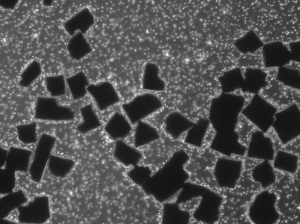A side view of cells with Galena
Choanoflagellates are a bit of a challenge to image in several ways. Putting aside the fact that many of them swim about a lot, even the ones that stick to surfaces tend to attach to the surface of the dish and point directly upwards—so they look like little circles under the microscope, their collars and flagella not visible because they are pointing directly towards you. What we need is a flat surface at right angles to the bottom of the dish, that the choanos can attach to and be in the perfect orientation for us to image them. We also need the substrate to be thin—too thick, and it’ll cut off part of the cone of light that forms the image.
I was thinking that the ideal solution would be (very) tiny cubes that would sit with one face on the surface of the dish, and the four adjacent faces providing good, flat, orthogonal surfaces for the choanos to attach to. What is small and cubic? I thought of salt—a naturally occurring cubic-lattice crystal, which wouldn’t work of course because it would dissolve, but lots of other crystals have cubic lattices! After ordering a few different minerals with cubic lattice crystals from Wards, and trying to crush them in a pestle and mortar to make tiny little cubes, I found one with the right properties—cheap, soft enough to crush into tiny crystals easily, and insoluble in water—Galena (Lead Sulphide).
The second challenge was to get a (reasonably) uniform size, which is actually really easy. Just start by griding up some galena in a mortar and pestle (feeling like an old alchemist). I did this with water to prevent dust because I didn’t want to inhale lead powder, and wearing gloves—small things tend to be rather biologically active, and I don’t want to absorb any lead through my skin if I can help it). Then I isolated a size range—putting the galena slush first through a large (150 µm) filter, keeping the flow-through (<150 µm), then through a small (30 µm) filter (nylon mesh) keeping the retentant (30–150 µm) and washing to remove all of the very small particles. I stored this under ethanol, to try to prevent the galena dissolving too much.
It works quite well (see Figure—click on it for a larger view). The crystals aren’t perfect cubes, but there are lots of flat surfaces orthogonal to the bottom of the dish, and the choanos attach all over them, their cell bodies lining up in their thecae a few microns from the surface. The crystals are thin enough not to disrupt the imaging too. The only downside is that they tend to slide over the bottom of the dish if you’re not careful, ploughing through the choanos on the surface and piling them up on the edge of the crystal. For long-term growth, I might be a bit concerned about lead dissolving into the solution, but I’m not sure how much of an issue this is—galena is not supposed to dissolve very much.
I’m not including any high res images of choanos taken this way, because we’re not yet sure which ones we might want to publish, but I may add some later.


